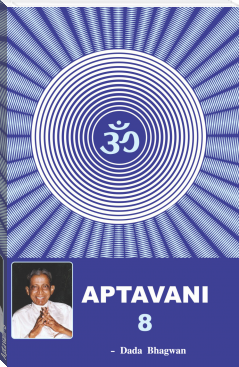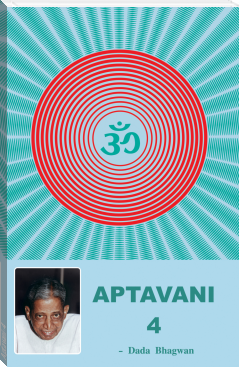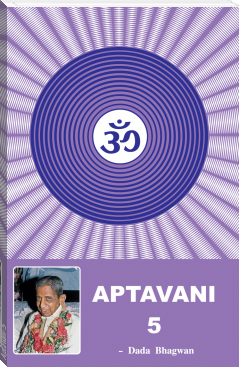Aptavani-8 by Dada Bhagwan (affordable ebook reader .txt) 📖

- Author: Dada Bhagwan
Book online «Aptavani-8 by Dada Bhagwan (affordable ebook reader .txt) 📖». Author Dada Bhagwan
In Part II, the Gnani addresses the fundamental question, Who Am I?
The reader-questioner, in his fervent desire to gain the Knowledge, is paving his way by asking questions like: How can I attain this Knowledge? How do I recognize the Self? How do I attain Self-realization? Etc...
Starting out with the doubts about the Atma’s very existence, one asks, what is the Atma? What is it like? What does it do? What is birth and death? Who takes birth and dies? What is karma? What are the four gati (realms of existence)? By what means does one secure one’s place in these gatis? What is moksha? What is Siddha gati (Final Liberation)? What are: pratishthit atma, mishra-chetan, nischetan chetan, ahamkar (ego), and all its resultant effects (vishesh parinam)? The answers to all these intricate questions have been disclosed here.
What is jiva (living entity; an embodied self)? What is Shiva (realized Atma)? What is dwaita (dualism)? What is adwaita (non-dualism)? What is Brahma (Supreme Self)? What is Parabrahma (Absolute Self)?
The dictum, Ekoham Bahusyam, ‘I am the One, and I became many.’ The omnipresence of Atma, the presence of God in every particle, the meaning of the Vedas and Science etc. – Are all truths of Vedanta that will open up here.
This gives you the true, primary but basic, understanding of the spirituality from which one has to pave the entire path for moksha (final liberation). The slightest of misinterpretation, will change one’s course, on the path that is parallel to the Gnani’s. Such a diversion will change the destination, so that after having traveled on the path for so many millions of miles, instead of reaching the destination, one finds oneself in a forsaken place.
‘I am a part of Parmatma (Absolute Soul)’ – If such an illusory belief prevails, when will you understand that You, yourself are the Absolute Soul ( Parmatma); you are independent; not a fraction, but the complete Self? And if it is not in your belief to begin with, then how can you attain such a state? There are so many of these illusory beliefs. They have come about as a result of secular and orthodox thought, which makes one’s conduct move away from the real Vision.
The essence of all scriptures, spiritual discipline, and the practice of spirituality is one: to secure the awareness of one’s own Atma (Self).
The real Atma truly is pure, but you hold a tuber of wrong belief, which only the living Gnani Purush can unravel. That which can never be attained even over millions of lifetimes, is finally made possible within an hour through the Gnani.
Millions of questions come from those who doubt, and from those who seek Self-realization. Nevertheless, the Gnani’s answers are spot on; his core definitions provide for the exactness to open, which gives evidence of the Gnani’s divine and perfectly clear Vision. To put it in his own words: “I answer by seeing through Absolute Knowledge (Keval Gnan)”. Moreover, he does not even have the inner intent (bhaav) of ownership, of his speech. The tape-record (tape player) is doing the talking. If the self were to speak, it would come out with many mistakes. But how can a tape-record make mistakes? ‘He’ himself is the Knower-Seer (Gnata-Drashta) of a tape-record.
For all those who are in search of Self-realization, and for all those who are deeply curious, innumerable questions related to the Atma and to the universe, have been compounded in this book. The wise aspirant will find the Eternal, elucidated for him in his own language. He will indeed experience the Eternal as it is. However, in order for him to come into this Vision and experience, he requires a Gnani. Only the living Gnani, – who resides in the absolute state of the Self – Dadashri, can give you this very experience of the Atma.
As it is, the profound discussions about Atmagnan (Self-knowledge) or Keval Gnan (Absolute Knowledge) have been fruitless when it comes to illuminating a single ray of the light of one’s own Atma. Unless you encounter a living Gnani, and unless you receive the Gnani’s Gnan, you will only dwell in words. The living Gnani’s single word, on the other hand, will pierce your heart, removing layers of infinite veils of dosh (faults) that have been, shrouding the supreme light of the Absolute Soul (Parmatma)that illuminates the entire universe. So that now, that same light shines within You.
Only those who have known this incomparable Gnani’s unparalleled siddhi (energy that accomplishes the ultimate) have relished its beauty. Otherwise, how would the light of the Atma, which cannot be described with words; be illuminated with words? The compassionate Dadashri had often said, ‘The person you see before you is not Dada Bhagwan. This is A. M. Patel. Dada Bhagwan is He that has manifested within. He ( Dada Bhagwan) is the Lord of the fourteen worlds! You may ask from Him anything that you want. But you do not even know how to fill that tender (request)!’ And that is a fact! Rather than asking for the domain of the whole universe, which is in His possession, the unfortunate seeker fills out a tender for a piece of plot (material things) instead. If at the time, one could have read the Gnani’s heart, it would have been overflowing with infinite compassion!
The existing wrong beliefs about the Atma (the Self), pushes one millions of miles away from the absolute truth. Regardless of not having attained Atmagnan (Self-realization), if you can manage to understand the Self, through that which the Gnani Purush has himself Seen, Known and Experienced, you will be halted from traveling in the wrong direction. In this very book, the revered Dadashri, from his own Gnan, expresses as it is, how he has seen, known, and experienced the swaroop (nature; form) of the Atma and the swaroop of the world. And for those who progress on the spiritual path, it will prove very useful for understanding the Atma.
The Gnani Purush’s speech flows naturally. It is dependent on the nimit (questioner) and on the circumstances. Should you come across any discrepancies or shortcomings in this book, it is an error in the compilation, made entirely on our part, and never in the words of the Gnani Purush. And for that, we pray for your forgiveness.
- Dr. Niruben Amin
INTRODUCTION
Part One
What is the Soul? What is it like?
Not being able to comprehend the subtlest and the most profound element in the universe, which is your own real form (swaroop; the Self); what You are yourself, thinkers are confounded by endless thoughts like: The Atma is like this, or is it like that? Is it in the form of light? And what would its illumination be like! The true Vision (darshan), that transcends imagination, the one that only the Gnani Purush has envisaged, can only be attained through him. For those who did not have the opportunity to meet him in person, this particular volume contains his spoken Knowledge (Gnan vani), which shows the real path, and leads one further and further along it.
The Self is truly who one is, and to know this is to know the Atma. And that is what you need to know.
He that has Known, Seen, Experienced and permanently lived in the swaroop (real form; the Self) of the Atma that is beyond doubt and imagination of shape or form; has said that it is beyond form (aakruti) and formlessness (niraakruti). The Atma’s real form is independent (niralumb) and illuminating (prakashak). It is not dependent on either time or place. That is the kind of Atma the Gnani dwells in. He is separate, the body is separate, and he interacts with the body as a neighbor.
No one, in the world is naastik (without existence). The awareness of one’s astitva (existence); I am, is there. Everyone with this awareness is aastik (with existence). The Atma has existence (astitva); it has elemental reality (vastutva) and completeness ( purnatva). Every living being has awareness of its existence (astitva); a rare person has the awareness of his reality (vastutva), and completeness (purnatva) is the reward of knowing one’s own real Self. Only the Knower of separation (Bheda-Gnani) can impart the awareness of one’s own real Self (vastutva), through his Knowledge of separation.
In giving credence to the conviction (pratiti) about the Atma, the Gnani says that, just as fragrance exposes the existence ( astitva) of perfume, the Atma – although invisible (aroopi) – can be discerned by its inherent blissful nature. The very state of the Absolute Soul (Parmatma) is infinite (anant) Knowledge (Gnan), infinite Vision (Darshan), infinite Energy (shakti), and infinite bliss (sukh). This is the You (the Self). But it is only after you have the realization of your own real form (swaroop),that all these qualities will be uncovered.
You can recognize the difference between chetan (Atma; the Self) and jada (non-Atma; inanimate) by their intrinsic properties ( gunadharma). Knowledge-Vision (Gnan-Darshan), to See and to Know, is the real nature (swabhav) of Atma (chetan; the Self). No other eternal element shares the same attribute (gunadharma).
Those who doubt the existence of Soul (jiva) are like people that would say, ‘there is no tongue in my mouth’. They are essentially exposing the existence of their own Atma (vastutva astitva). The one, who creates the doubt about Soul, is indeed the self. Is it possible for the nonliving (jada; non-Atma) to have doubt?
Even in the darkness, the Soul (jiva) will recognize all the individual ingredients of the spoonful of shrikhand (sweet yogurt pudding) in the mouth. The sensory nerves carry the message, but the One who knows, is the Atma. It is the soul (jiva) itself that has always been the one to desire and seek bliss.
Where there is feeling; there is Atma (Self), and where there is no feeling there is no Atma. And yet, the Atma has no feeling. It is the pudgal (the physical gross and subtle non-Self complex) that has feeling. That which moves, speaks, eats and drinks is not Atma ( chetan), but where there is any knowledge or ignorance; sympathy or feeling, there is chetan (Atma, Self).
The Atma is spread throughout the entire body. Where pain is felt; the Atma is present. Only in the nails and in the hair the Atma is absent. The abode of the gross mind (sthool mun) is in the heart. Whereas the subtle mind (sookshma mun) is located between the two eyebrows, two and a half inches deep.
Because of the Atma’s nature and capability to expand and contract (sankoch-vikaasshil), whenever a part of the body is severed or during anesthesia, the Atma moves away from that area.
In all the three stages of life; Oh! In the phases of infinite lifetimes of birth and death, the Atma always remains the same: immortal. It exists in its own nature (swabhav) infinitely. For innumerable births the Atma has had to accompany the body-complex (pudgal). Once the wrong belief (about one’s real identity) is gone, one becomes independent. Completely independent! In fact neither has the non-Self body complex (pudgal) cohered to the Atma, nor has the Atma cohered to the body complex. The





Comments (0)